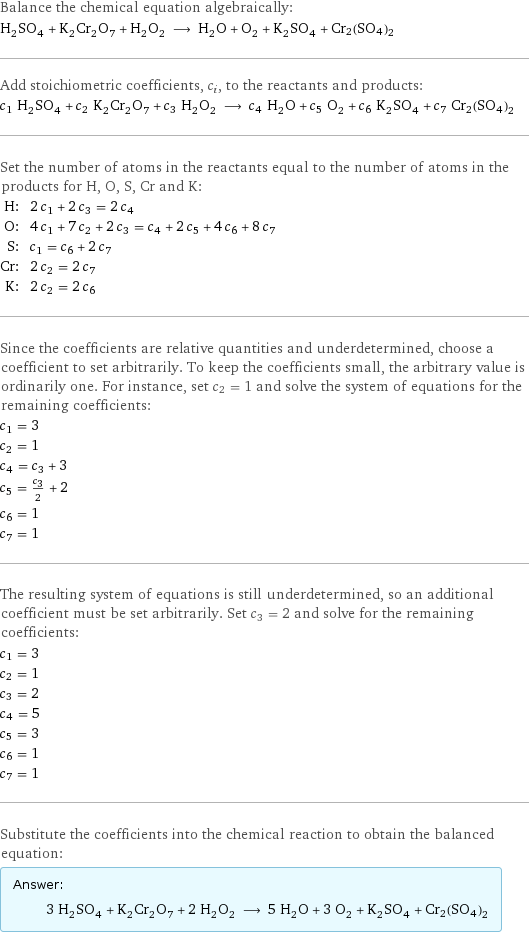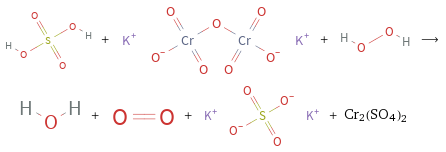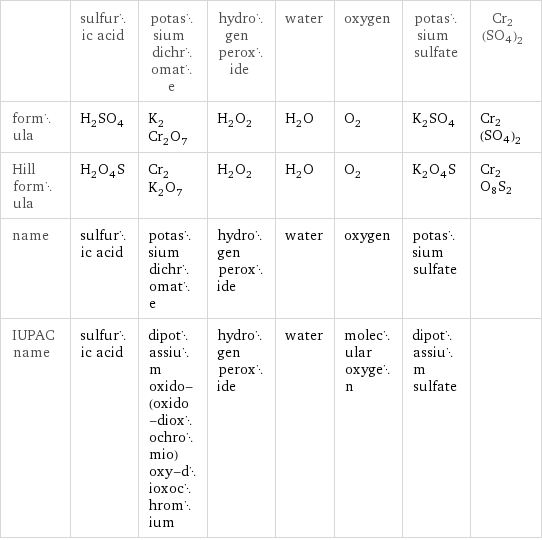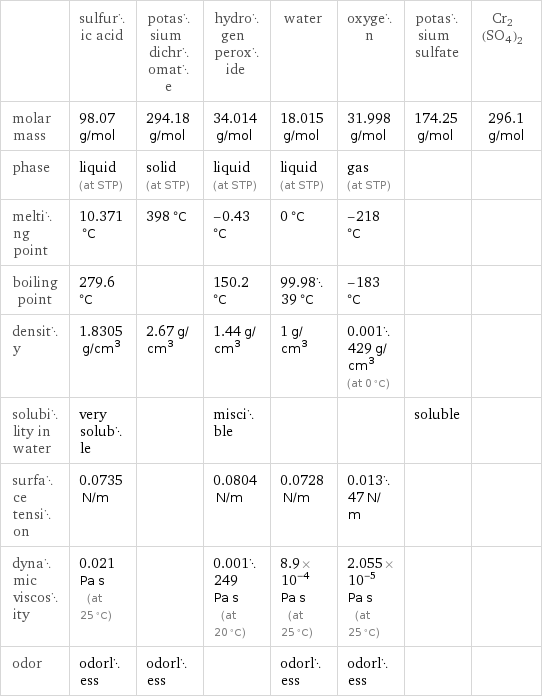Input interpretation

H_2SO_4 sulfuric acid + K_2Cr_2O_7 potassium dichromate + H_2O_2 hydrogen peroxide ⟶ H_2O water + O_2 oxygen + K_2SO_4 potassium sulfate + Cr2(SO4)2
Balanced equation

Balance the chemical equation algebraically: H_2SO_4 + K_2Cr_2O_7 + H_2O_2 ⟶ H_2O + O_2 + K_2SO_4 + Cr2(SO4)2 Add stoichiometric coefficients, c_i, to the reactants and products: c_1 H_2SO_4 + c_2 K_2Cr_2O_7 + c_3 H_2O_2 ⟶ c_4 H_2O + c_5 O_2 + c_6 K_2SO_4 + c_7 Cr2(SO4)2 Set the number of atoms in the reactants equal to the number of atoms in the products for H, O, S, Cr and K: H: | 2 c_1 + 2 c_3 = 2 c_4 O: | 4 c_1 + 7 c_2 + 2 c_3 = c_4 + 2 c_5 + 4 c_6 + 8 c_7 S: | c_1 = c_6 + 2 c_7 Cr: | 2 c_2 = 2 c_7 K: | 2 c_2 = 2 c_6 Since the coefficients are relative quantities and underdetermined, choose a coefficient to set arbitrarily. To keep the coefficients small, the arbitrary value is ordinarily one. For instance, set c_2 = 1 and solve the system of equations for the remaining coefficients: c_1 = 3 c_2 = 1 c_4 = c_3 + 3 c_5 = c_3/2 + 2 c_6 = 1 c_7 = 1 The resulting system of equations is still underdetermined, so an additional coefficient must be set arbitrarily. Set c_3 = 2 and solve for the remaining coefficients: c_1 = 3 c_2 = 1 c_3 = 2 c_4 = 5 c_5 = 3 c_6 = 1 c_7 = 1 Substitute the coefficients into the chemical reaction to obtain the balanced equation: Answer: | | 3 H_2SO_4 + K_2Cr_2O_7 + 2 H_2O_2 ⟶ 5 H_2O + 3 O_2 + K_2SO_4 + Cr2(SO4)2
Structures

+ + ⟶ + + + Cr2(SO4)2
Names

sulfuric acid + potassium dichromate + hydrogen peroxide ⟶ water + oxygen + potassium sulfate + Cr2(SO4)2
Equilibrium constant
![Construct the equilibrium constant, K, expression for: H_2SO_4 + K_2Cr_2O_7 + H_2O_2 ⟶ H_2O + O_2 + K_2SO_4 + Cr2(SO4)2 Plan: • Balance the chemical equation. • Determine the stoichiometric numbers. • Assemble the activity expression for each chemical species. • Use the activity expressions to build the equilibrium constant expression. Write the balanced chemical equation: 3 H_2SO_4 + K_2Cr_2O_7 + 2 H_2O_2 ⟶ 5 H_2O + 3 O_2 + K_2SO_4 + Cr2(SO4)2 Assign stoichiometric numbers, ν_i, using the stoichiometric coefficients, c_i, from the balanced chemical equation in the following manner: ν_i = -c_i for reactants and ν_i = c_i for products: chemical species | c_i | ν_i H_2SO_4 | 3 | -3 K_2Cr_2O_7 | 1 | -1 H_2O_2 | 2 | -2 H_2O | 5 | 5 O_2 | 3 | 3 K_2SO_4 | 1 | 1 Cr2(SO4)2 | 1 | 1 Assemble the activity expressions accounting for the state of matter and ν_i: chemical species | c_i | ν_i | activity expression H_2SO_4 | 3 | -3 | ([H2SO4])^(-3) K_2Cr_2O_7 | 1 | -1 | ([K2Cr2O7])^(-1) H_2O_2 | 2 | -2 | ([H2O2])^(-2) H_2O | 5 | 5 | ([H2O])^5 O_2 | 3 | 3 | ([O2])^3 K_2SO_4 | 1 | 1 | [K2SO4] Cr2(SO4)2 | 1 | 1 | [Cr2(SO4)2] The equilibrium constant symbol in the concentration basis is: K_c Mulitply the activity expressions to arrive at the K_c expression: Answer: | | K_c = ([H2SO4])^(-3) ([K2Cr2O7])^(-1) ([H2O2])^(-2) ([H2O])^5 ([O2])^3 [K2SO4] [Cr2(SO4)2] = (([H2O])^5 ([O2])^3 [K2SO4] [Cr2(SO4)2])/(([H2SO4])^3 [K2Cr2O7] ([H2O2])^2)](../image_source/eadd5c516b5bf64872d60a4f4ad6c348.png)
Construct the equilibrium constant, K, expression for: H_2SO_4 + K_2Cr_2O_7 + H_2O_2 ⟶ H_2O + O_2 + K_2SO_4 + Cr2(SO4)2 Plan: • Balance the chemical equation. • Determine the stoichiometric numbers. • Assemble the activity expression for each chemical species. • Use the activity expressions to build the equilibrium constant expression. Write the balanced chemical equation: 3 H_2SO_4 + K_2Cr_2O_7 + 2 H_2O_2 ⟶ 5 H_2O + 3 O_2 + K_2SO_4 + Cr2(SO4)2 Assign stoichiometric numbers, ν_i, using the stoichiometric coefficients, c_i, from the balanced chemical equation in the following manner: ν_i = -c_i for reactants and ν_i = c_i for products: chemical species | c_i | ν_i H_2SO_4 | 3 | -3 K_2Cr_2O_7 | 1 | -1 H_2O_2 | 2 | -2 H_2O | 5 | 5 O_2 | 3 | 3 K_2SO_4 | 1 | 1 Cr2(SO4)2 | 1 | 1 Assemble the activity expressions accounting for the state of matter and ν_i: chemical species | c_i | ν_i | activity expression H_2SO_4 | 3 | -3 | ([H2SO4])^(-3) K_2Cr_2O_7 | 1 | -1 | ([K2Cr2O7])^(-1) H_2O_2 | 2 | -2 | ([H2O2])^(-2) H_2O | 5 | 5 | ([H2O])^5 O_2 | 3 | 3 | ([O2])^3 K_2SO_4 | 1 | 1 | [K2SO4] Cr2(SO4)2 | 1 | 1 | [Cr2(SO4)2] The equilibrium constant symbol in the concentration basis is: K_c Mulitply the activity expressions to arrive at the K_c expression: Answer: | | K_c = ([H2SO4])^(-3) ([K2Cr2O7])^(-1) ([H2O2])^(-2) ([H2O])^5 ([O2])^3 [K2SO4] [Cr2(SO4)2] = (([H2O])^5 ([O2])^3 [K2SO4] [Cr2(SO4)2])/(([H2SO4])^3 [K2Cr2O7] ([H2O2])^2)
Rate of reaction
![Construct the rate of reaction expression for: H_2SO_4 + K_2Cr_2O_7 + H_2O_2 ⟶ H_2O + O_2 + K_2SO_4 + Cr2(SO4)2 Plan: • Balance the chemical equation. • Determine the stoichiometric numbers. • Assemble the rate term for each chemical species. • Write the rate of reaction expression. Write the balanced chemical equation: 3 H_2SO_4 + K_2Cr_2O_7 + 2 H_2O_2 ⟶ 5 H_2O + 3 O_2 + K_2SO_4 + Cr2(SO4)2 Assign stoichiometric numbers, ν_i, using the stoichiometric coefficients, c_i, from the balanced chemical equation in the following manner: ν_i = -c_i for reactants and ν_i = c_i for products: chemical species | c_i | ν_i H_2SO_4 | 3 | -3 K_2Cr_2O_7 | 1 | -1 H_2O_2 | 2 | -2 H_2O | 5 | 5 O_2 | 3 | 3 K_2SO_4 | 1 | 1 Cr2(SO4)2 | 1 | 1 The rate term for each chemical species, B_i, is 1/ν_i(Δ[B_i])/(Δt) where [B_i] is the amount concentration and t is time: chemical species | c_i | ν_i | rate term H_2SO_4 | 3 | -3 | -1/3 (Δ[H2SO4])/(Δt) K_2Cr_2O_7 | 1 | -1 | -(Δ[K2Cr2O7])/(Δt) H_2O_2 | 2 | -2 | -1/2 (Δ[H2O2])/(Δt) H_2O | 5 | 5 | 1/5 (Δ[H2O])/(Δt) O_2 | 3 | 3 | 1/3 (Δ[O2])/(Δt) K_2SO_4 | 1 | 1 | (Δ[K2SO4])/(Δt) Cr2(SO4)2 | 1 | 1 | (Δ[Cr2(SO4)2])/(Δt) (for infinitesimal rate of change, replace Δ with d) Set the rate terms equal to each other to arrive at the rate expression: Answer: | | rate = -1/3 (Δ[H2SO4])/(Δt) = -(Δ[K2Cr2O7])/(Δt) = -1/2 (Δ[H2O2])/(Δt) = 1/5 (Δ[H2O])/(Δt) = 1/3 (Δ[O2])/(Δt) = (Δ[K2SO4])/(Δt) = (Δ[Cr2(SO4)2])/(Δt) (assuming constant volume and no accumulation of intermediates or side products)](../image_source/f067a6399476cd084e2066612c556a68.png)
Construct the rate of reaction expression for: H_2SO_4 + K_2Cr_2O_7 + H_2O_2 ⟶ H_2O + O_2 + K_2SO_4 + Cr2(SO4)2 Plan: • Balance the chemical equation. • Determine the stoichiometric numbers. • Assemble the rate term for each chemical species. • Write the rate of reaction expression. Write the balanced chemical equation: 3 H_2SO_4 + K_2Cr_2O_7 + 2 H_2O_2 ⟶ 5 H_2O + 3 O_2 + K_2SO_4 + Cr2(SO4)2 Assign stoichiometric numbers, ν_i, using the stoichiometric coefficients, c_i, from the balanced chemical equation in the following manner: ν_i = -c_i for reactants and ν_i = c_i for products: chemical species | c_i | ν_i H_2SO_4 | 3 | -3 K_2Cr_2O_7 | 1 | -1 H_2O_2 | 2 | -2 H_2O | 5 | 5 O_2 | 3 | 3 K_2SO_4 | 1 | 1 Cr2(SO4)2 | 1 | 1 The rate term for each chemical species, B_i, is 1/ν_i(Δ[B_i])/(Δt) where [B_i] is the amount concentration and t is time: chemical species | c_i | ν_i | rate term H_2SO_4 | 3 | -3 | -1/3 (Δ[H2SO4])/(Δt) K_2Cr_2O_7 | 1 | -1 | -(Δ[K2Cr2O7])/(Δt) H_2O_2 | 2 | -2 | -1/2 (Δ[H2O2])/(Δt) H_2O | 5 | 5 | 1/5 (Δ[H2O])/(Δt) O_2 | 3 | 3 | 1/3 (Δ[O2])/(Δt) K_2SO_4 | 1 | 1 | (Δ[K2SO4])/(Δt) Cr2(SO4)2 | 1 | 1 | (Δ[Cr2(SO4)2])/(Δt) (for infinitesimal rate of change, replace Δ with d) Set the rate terms equal to each other to arrive at the rate expression: Answer: | | rate = -1/3 (Δ[H2SO4])/(Δt) = -(Δ[K2Cr2O7])/(Δt) = -1/2 (Δ[H2O2])/(Δt) = 1/5 (Δ[H2O])/(Δt) = 1/3 (Δ[O2])/(Δt) = (Δ[K2SO4])/(Δt) = (Δ[Cr2(SO4)2])/(Δt) (assuming constant volume and no accumulation of intermediates or side products)
Chemical names and formulas

| sulfuric acid | potassium dichromate | hydrogen peroxide | water | oxygen | potassium sulfate | Cr2(SO4)2 formula | H_2SO_4 | K_2Cr_2O_7 | H_2O_2 | H_2O | O_2 | K_2SO_4 | Cr2(SO4)2 Hill formula | H_2O_4S | Cr_2K_2O_7 | H_2O_2 | H_2O | O_2 | K_2O_4S | Cr2O8S2 name | sulfuric acid | potassium dichromate | hydrogen peroxide | water | oxygen | potassium sulfate | IUPAC name | sulfuric acid | dipotassium oxido-(oxido-dioxochromio)oxy-dioxochromium | hydrogen peroxide | water | molecular oxygen | dipotassium sulfate |
Substance properties

| sulfuric acid | potassium dichromate | hydrogen peroxide | water | oxygen | potassium sulfate | Cr2(SO4)2 molar mass | 98.07 g/mol | 294.18 g/mol | 34.014 g/mol | 18.015 g/mol | 31.998 g/mol | 174.25 g/mol | 296.1 g/mol phase | liquid (at STP) | solid (at STP) | liquid (at STP) | liquid (at STP) | gas (at STP) | | melting point | 10.371 °C | 398 °C | -0.43 °C | 0 °C | -218 °C | | boiling point | 279.6 °C | | 150.2 °C | 99.9839 °C | -183 °C | | density | 1.8305 g/cm^3 | 2.67 g/cm^3 | 1.44 g/cm^3 | 1 g/cm^3 | 0.001429 g/cm^3 (at 0 °C) | | solubility in water | very soluble | | miscible | | | soluble | surface tension | 0.0735 N/m | | 0.0804 N/m | 0.0728 N/m | 0.01347 N/m | | dynamic viscosity | 0.021 Pa s (at 25 °C) | | 0.001249 Pa s (at 20 °C) | 8.9×10^-4 Pa s (at 25 °C) | 2.055×10^-5 Pa s (at 25 °C) | | odor | odorless | odorless | | odorless | odorless | |
Units
